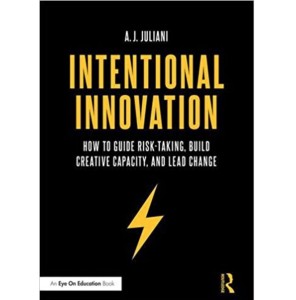 How can educators prepare students for an uncertain future? A.J. Juliani, a former middle and high school teacher, education consultant, author, and the current director of technology and innovation for Centennial School District, tackles this question by offering practical and digestible advice to help educators implement innovative practices and support their students in becoming innovators. Intentional Innovation: How to Guide Risk-Taking, Build Creative Capacity, and Lead Change argues that we can create innovative classrooms and prepare students for tomorrow by understanding how they learn, while valuing relationships first and foremost, creating student-center learning environments, providing opportunities to create, fostering a safe space to take risks and fail, and recognizing that any person with passion can be an innovator. Juliani suggests that the acronym PLASMA—Praise, Look for, Assess, Support differences, Make time for creative work, and Allow for the new and unknown—is a useful self-assessment, planning, and observation tool to bring about innovation.
How can educators prepare students for an uncertain future? A.J. Juliani, a former middle and high school teacher, education consultant, author, and the current director of technology and innovation for Centennial School District, tackles this question by offering practical and digestible advice to help educators implement innovative practices and support their students in becoming innovators. Intentional Innovation: How to Guide Risk-Taking, Build Creative Capacity, and Lead Change argues that we can create innovative classrooms and prepare students for tomorrow by understanding how they learn, while valuing relationships first and foremost, creating student-center learning environments, providing opportunities to create, fostering a safe space to take risks and fail, and recognizing that any person with passion can be an innovator. Juliani suggests that the acronym PLASMA—Praise, Look for, Assess, Support differences, Make time for creative work, and Allow for the new and unknown—is a useful self-assessment, planning, and observation tool to bring about innovation.
Learning, Juliani states, is a process of experimentation. We need to constantly learn, unlearn, and relearn information, especially given the current rapid pace at which information develops. Interest and necessity motivate people to learn. Attention to the to-be-learned material allows for it to be properly encoded, stored in memory, and ultimately retrieved.
Equipped with an understanding of how people learn, it is possible to understand how to support them in innovating. Some of the steps educators can take to help students become more innovative include: modeling how to learn, providing opportunities for collaboration and relationship building, embracing technology, measuring learning in creative ways, making classrooms enjoyable, and propagating the idea that we can all be innovators, especially if we focus greater energy on creating. Juliani allows his students to try their hand at innovating by using the “20% rule.” The students spend 20% of their class time pursuing an innovative project of their choice. He supports them in their work but gives them tremendous freedom. Juliani offers other ways to spur innovation, such as creating opportunities for students to learn outside of school in the community, encouraging students to teach what they know (e.g., through YouTube tutorial videos), giving students a voice in the assessment process, and having students debate one another.
Students are more likely to demonstrate creativity when they feel supported, understand the importance of effort, develop productive habits, are allowed to follow their own interests, and can engage in authentic work. Educators should bear in mind that allowing for creativity in students will take time and can feel slower than directing students more explicitly. Juliani refers to Jessica Lahey’s The Gift of Failure (reviewed here at Learning and the Brain) to remind educators that students learn and develop self-control and creative abilities when they are allowed to fail and pick themselves back up. This is especially true in a culture in which failure is not embarrassing but rather a sign of learning.
A book about innovation in education would not be complete without a discussion of technology. Juliani argues that although few modern technologies were specifically designed for education and none has proven to be an elixir for improving education, technology has changed the experience of students and teachers in many ways. We no longer need to store vast amounts of information to be considered intelligent; rather, what is most important, according to Juliani, is to be able to find and create with information. Educators should use technologies like social media platforms to engage students in the arenas in which they are already engaged. While technology inevitably changes what happens in education, the key ingredient—supportive relationships—will always remain the same. Teachers should challenge students, provide opportunities for inquiry, solve problems collaboratively, and get to know students personally. Similarly, teachers can improve their own practice by cultivating strong relations with other teachers.
Innovative educational practices and support of students in developing skills as innovators are both valuable and necessary components of education. As educators innovate, it is incumbent upon them to remember that innovation is not primarily about novelty; it is about service to others and impact upon them. Indeed, Juliani has demonstrated his innovativeness with this book that is likely to spur many ideas for educators about how to innovate.
Juliani, A. J. (2017). Intentional Innovation: How to Guide Risk-Taking, Build Creative Capacity, and Lead Change. New York, NY: Routledge.



